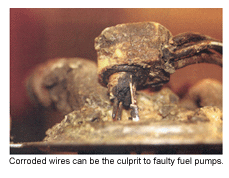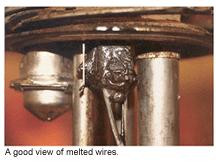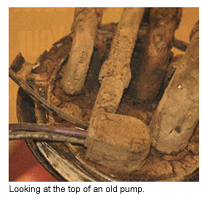Are the fuel pump returns from your shop going up? Understanding the root cause of technician errors is the first step to successfully managing fuel system parts purchases and returns.
Over the years, vehicle fuel systems have become more complex as OEs look to improve fuel burning and engine efficiency. And during that time, industry parts suppliers have noted that too many technicians are returning brand-new fuel pumps as defective, only to later discover that the root cause of the problem was a bad crankshaft sensor or fuel pump relay. As a technician, it’s important that you keep up with modern fuel system technology. So in order to avoid some of the most common technician mistakes in fuel system diagnosis, let’s look at how some of today’s most common fuel systems operate, and what some of the common failures and “silver bullet fixes” may be.
Inaccurate Level Readings
A vehicle’s fuel level must be accurately measured by the PCM in order to detect evaporative leaks. Consequently, newer fuel gauge configurations often incorporate a small module that may require as much as 20 minutes to compute the actual fuel level in the fuel tank. Without this particular bit of knowledge, many amateur mechanics may assume that a tank is half-full of fuel when, in fact, it is not.
In addition, a fuel pump inlet strainer may be installed so that it interferes with the travel on the fuel level sensor’s float arm and causes an optimistic fuel level reading. Dented fuel tanks may also cause a false reading by pushing the fuel level sensor and fuel pump inlet filter above the remaining fuel level in the tank. Whatever the case, the engine may be running out of gas simply because the instrument panel fuel gauge is providing a false reading.
 Silently Working
Silently Working
Under normal circumstances, most fuel pumps produce an audible noise for several seconds after the ignition switch is turned on. The relatively silent two-speed fuel pumps used in many import and domestic vehicles may, however, lead a technician to believe that the fuel pump is defective. Since the fuel pump speed in these applications is dependent upon engine speed and load, a fuel pressure gauge should be used to determine if the pump is operating and if it’s delivering the correct fuel pump pressure.
Of course, if the gauge doesn’t show fuel pressure, we must remember how most fuel pumps are activated. When the ignition switch is turned on, the PCM activates the fuel pump for a few seconds to purge air from the fuel injectors and to build fuel pressure for the engine’s cranking cycle. Once the engine is cranked, the PCM “looks” for the presence of cranking speed and ignition triggering. Depending upon design, the PCM turns off the fuel pump if one or both of these inputs are missing. This specific sequence of events is necessary to prevent fuel from flooding an engine with an inoperative ignition system or the fuel pump from emptying the fuel tank during a serious accident.
Running the Relays
A fuel pump relay is a high-current electrical switch operated by a low-current circuit in the PCM. As with all electrical switches, the contact points on the fuel pump relay eventually wear out, which reduces electric current flow to the fuel pump. Since this reduced current flow also reduces fuel pump speed, the engine may experience difficulty starting in cold weather, when battery voltage may be lower than normal.
In many pre-1996 Ford applications, worn fuel pump relay contacts typically stick closed, which drains the battery after the engine is shut off. Remember, too, that a worn ECM relay on pre-1996 Fords will also cause the fuel pump not to activate, especially if battery voltage happens to be low.
 In a typical General Motors application, long cranking times may be caused by the engine oil pressure switch bypassing a failed fuel pump relay after the engine is cranked long enough to build up oil pressure. In Chrysler applications, an auto shut down (ASD) activates the ignition system and fuel pump. Before replacing a fuel pump, remind your installer that a signal from the crankshaft position sensor (CKP) to the PCM is required before the PCM will close the ASD relay and fuel pump circuit.
In a typical General Motors application, long cranking times may be caused by the engine oil pressure switch bypassing a failed fuel pump relay after the engine is cranked long enough to build up oil pressure. In Chrysler applications, an auto shut down (ASD) activates the ignition system and fuel pump. Before replacing a fuel pump, remind your installer that a signal from the crankshaft position sensor (CKP) to the PCM is required before the PCM will close the ASD relay and fuel pump circuit.
No-Go Airflow
A dirty or defective airflow sensor, especially on Ford products, often causes stalling and surging complaints normally associated with a worn fuel pump. In the case of many imports, a signal from a vane-type airflow sensor activates the fuel pump relay. If an air leak is present in the duct between the airflow sensor and the throttle plate, the sensor won’t activate the fuel pump during cranking, and the engine will fail to start. A simple test is to remove the air filter and manually open the airflow sensor vane a slight amount during cranking. If the fuel pump activates, the problem exists with the air duct, not the fuel pump.
Primary Pumps
Early 1980s import and domestic fuel injection systems used a low-pressure primary supply fuel pump located in the fuel tank to supply a secondary, high-pressure fuel pump located on the vehicle frame. Remember that overlooking a worn primary fuel pump may cause successive failures in the high-pressure fuel pump.
Similarly, many technicians test fuel pressure only to ignore fuel volume. Without adequate fuel volume, an engine will generally lose power under load. While a clogged fuel filter usually causes low volume, a worn fuel pump may also cause the same symptoms, especially after an extended period of operation. Clogged fuel filters also cause rapid fuel pump wear, which is why the fuel filter should be changed at 30,000-mile intervals and after installing a new fuel pump.
 The Regulators
The Regulators
Defective fuel pressure regulators most often develop excessive pressures that drive the fuel injectors rich. Similarly, if the pressure regulator diaphragm leaks through its vacuum hose into the engine intake manifold, the fuel mixture will also become excessively rich.
While most conventional fuel pressure regulators are located at the end of the fuel injector rail, many new single-line systems incorporate the fuel pressure regulator in the fuel pump module, along with the fuel level sensor and fuel pump. In most cases, a pressure regulator failure requires replacement of the entire fuel pump module assembly.
Injector Issues
Some fuel injectors are prone to external fuel leakage, while others are prone to internal electrical shorts that prevent the injector from opening properly. Most fuel injectors, however, will last the life of the vehicle and require only an occasional flushing or cleaning to maintain efficient operation.
One exception to conventional fuel injector diagnostics is the General Motors Vortec system, which locates the fuel pressure regulator, fuel injectors and fuel injector nozzles inside the intake manifold. Consequently, a fuel pressure regulator or injector fuel line leak will cause rich operation. More specific to the Vortec, low-quality fuel can cause the fuel injector nozzles to “stick” closed and cause an engine miss, which results in an illuminated MIL and causes a P0300 misfire trouble code to be stored in the PCM’s diagnostic memory. Many untrained installers will attribute this to spark plug failure. While professional attention is required to unclog Vortec injectors, recommending a quality fuel injector-cleaning additive to add to the fuel tank after each oil change will help avoid recurrences of this very “sticky” problem.
|













